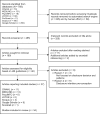Parents' disclosure to their donor-conceived children in the last 10 years and factors affecting disclosure: a narrative review
- PMID: 38687968
- PMCID: PMC11215159
- DOI: 10.1093/humupd/dmae010
Parents' disclosure to their donor-conceived children in the last 10 years and factors affecting disclosure: a narrative review
Abstract
Background: Disclosure of donor conception has been advocated in several jurisdictions in recent years, especially in those that practice identity-release donation. However, research on disclosure decisions has not been consolidated systematically in the last 10 years to review if parents are telling and what factors may be impacting their decisions.
Objective and rationale: Are parents disclosing to their donor-conceived children, and what factors have influenced their disclosure decisions across different contexts and family forms in the last 10 years?
Search methods: A bibliographic search of English-language, peer-reviewed journal articles published between 2012 and 2022 from seven databases was undertaken. References cited in included articles were manually scrutinized to identify additional references and references that cited the included articles were also manually searched. Inclusion criteria were articles focused on parents (including heterosexual, single mothers by choice, same-sex couples, and transsexual) of donor-conceived persons in both jurisdictions with or without identity-release provisions. Studies focused solely on surrogacy, donors, donor-conceived persons, or medical/fertility staff were excluded as were studies where it was not possible to extract donor-recipient parents' data separately. Both quantitative and qualitative studies were included. Preferred Reporting Items for Systematic Reviews and Meta-Analyses guidelines were followed and Joanna Briggs Institute Critical Appraisal Tools for Systematic Reviews were used to assess article quality and bias.
Outcomes: Thirty-seven articles met the inclusion criteria representing 34 studies and 4248 parents (including heterosexual, single, same-sex, and transsexual parents although the majority were heterosexual) from countries with anonymous donation and those with identity-release provisions or who had subsequently enacted these provisions (Australia, Belgium, Finland, France, Hong Kong, Middle East, Spain, Sweden, the UK, and the USA) A general trend towards disclosure was noted across these groups of parents with most disclosing to their donor-conceived children before the age of 10 years. Further, the majority of those who had not yet told, reported planning to disclose, although delayed decisions were also associated with lower disclosure overall. Same-sex and single parents were more likely to disclose than heterosexual parents. There was recognition of disclosure as a process involving ongoing conversations and that decisions were impacted by multiple interacting intrapersonal, interpersonal, and external contextual and social factors. Methodological limitations, such as the different population groups and contexts from which participants were drawn (including that those parents who choose not to disclose may be less likely to participate in research), are acknowledged in integrating findings.
Wider implications: This review has reinforced the need for a theoretical model to explain parents' disclosure decisions and research exploring the role of legislative provisions, culture, and donor/family type in decision-making. Greater ongoing access to psychological support around disclosure may be important to promote parent and family well-being.
Keywords: anonymous donation; embryo donation; gamete donation; identity-release; oocyte/egg donation; parental disclosure; sperm donation.
© The Author(s) 2024. Published by Oxford University Press on behalf of European Society of Human Reproduction and Embryology.
Conflict of interest statement
There are no competing interests to disclose.
Figures


Similar articles
-
Using the theory of planned behavior to predict parents' disclosure of donor conception to their children: a longitudinal study.Hum Reprod. 2024 Jun 3;39(6):1247-1255. doi: 10.1093/humrep/deae070. Hum Reprod. 2024. PMID: 38593421 Free PMC article.
-
Parent psychological adjustment, donor conception and disclosure: a follow-up over 10 years.Hum Reprod. 2014 Nov;29(11):2487-96. doi: 10.1093/humrep/deu231. Epub 2014 Sep 19. Hum Reprod. 2014. PMID: 25240010 Free PMC article.
-
Understanding parents' intention to disclose the donor conception to their child by application of the theory of planned behaviour.Hum Reprod. 2021 Jan 25;36(2):395-404. doi: 10.1093/humrep/deaa299. Hum Reprod. 2021. PMID: 33367734 Free PMC article.
-
The impact of disclosure on donor gamete participants: donors, intended parents and offspring.Curr Opin Obstet Gynecol. 2008 Jun;20(3):265-8. doi: 10.1097/GCO.0b013e32830136ca. Curr Opin Obstet Gynecol. 2008. PMID: 18460941 Review.
-
Disclosure of donor conception in the era of non-anonymity: safeguarding and promoting the interests of donor-conceived individuals?Hum Reprod. 2016 Nov;31(11):2416-2420. doi: 10.1093/humrep/dew240. Epub 2016 Oct 3. Hum Reprod. 2016. PMID: 27698073 Review.
Cited by
-
The relationship between cognitive characteristics of irrational parenthood and stigma in female patients with infertility: a potential profile analysis.Rev Esc Enferm USP. 2025 Apr 14;59:e20240326. doi: 10.1590/1980-220X-REEUSP-2024-0326en. eCollection 2025. Rev Esc Enferm USP. 2025. PMID: 40233207 Free PMC article.
-
Misattributed paternity discovery: A critique of medical organizations' recommendations.Am J Hum Genet. 2025 Mar 6;112(3):492-507. doi: 10.1016/j.ajhg.2025.01.006. Epub 2025 Feb 3. Am J Hum Genet. 2025. PMID: 39904342 Review.
References
-
- Applegarth LD, Kaufman NL, Josephs-Sohan M, Christos PJ, Rosenwaks Z.. Parental disclosure to offspring created with oocyte donation: intentions versus reality. Hum Reprod 2016;31:1809–1815. - PubMed
-
- Beeson DR, Jennings PK, Kramer W.. Offspring searching for their sperm donors: how family type shapes the process. Hum Reprod 2011;26:2415–2424. - PubMed
-
- Best S, Goedeke S, Thorpe M.. Make our wellbeing a priority: donor-conceived adults call for ongoing support and conversation about their donor conception. Hum Fertil (Camb) 2023;26:337–346. - PubMed
Publication types
MeSH terms
LinkOut - more resources
Full Text Sources
Miscellaneous

